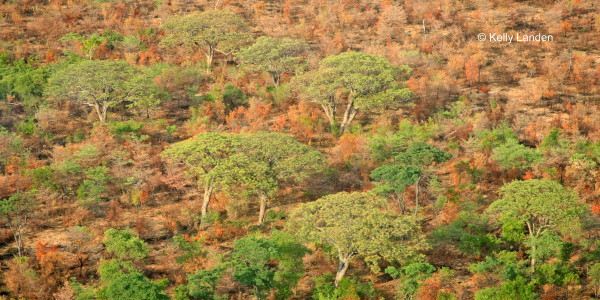The Bushmen call it Mongongo
As EWB continues with our survey work, we have been noting various habitats and environmental degradation due to fires, drought, flooding, elephants and other wildlife species. We cannot help but focus when we see whole floodplains completely charred to black ash without a blade of grass in sight, or young forests that had not yet developed to uphold during the unsuspecting floods, or areas where virtually almost every tree has been mutilated, knocked down and consumed by massive groups of elephants hording what they can while they wait to move onto greener pastures. Some of what we see is disheartening, but then again, some of it can be rather spectacular. Particular observations noted with pleasure, are areas where the diminishing Mongongo Tree has managed to survive, flourish and are in full, glorious bloom.

Elephant herd finding respite under a blooming Mongongo
The Bushmen of the Kalahari call it the Mongongo, also known as Manketti or in Latin, Ricinodendron rautaneii. It grows up to 15 meters, a “golden” straight trunked tree with a road spreading dark, green crown, which provides a respite of cool shade to wildlife. The wood is a lightweight, stong, durable “soft” wood, much like Balsa, which seems to be quite vulnerable to fires. We found this evident, observing where the base of trees had been scarred by grass fires, the trees succumbed and toppled. At this time of year here, Oct-Dec, the tree is covered with small-whitish yellow flowers, which eventually will become an oval plum-like, pleasantly aromatic, sweet fruit. Strangely, this tree does not bare fruit until it is at least 25 years old. However, it is not the fruit, but the Mongongo’s seed that it is valued for. The seeds or correctly, nuts, are high in protein, vitamin E, calcium, other minerals, and is 57% fat. The creamy yellow nut is very good eaten raw, but even more delicious roasted, tasting much like roasted cashews. Indigenous people collect them and are a major component of a balanced diet in some communities. Mongongo oil is excellent and is used as a moisturizer which is good for skin, hair and nails. The nut is covered by a thick, hard, yet porous shell, which is undeniably tough to crack. To access the edible nuts inside, people must “heat treat” them to force them open. But even a better way is to let elephants do the job for them! Yes, elephants love Mongongo nuts and consume them greedily. But ironically elephant’s digestive mechanism does not affect the extremely hard shell and meat inside. Therefore, people follow the elephants to recover the nuts from the elephants’ dung, where they have dropped them. Too, the shells and dung are collected which can also be burned as fuel! Rumor has it that elephants and mongongo trees hold a closer relationship than noted as just an ideal food source for the latter. Rather the seeds of a mongongo cannot germinate until it has spent a week within the digestive tract of an elephant!
The Monogongo tree is not only beautiful, but a valuable environmental resource to both wildlife and Indigenous people. But the trees are dwindling in numbers, taking their toll as many of the forests and tree species are, and it is becoming rare to know where the tracts of Mongongos flourish. After flying as we have, and having the opportunity to take note of these uncommon places, we can’t help feel even more motivated in doing something to protect these beautiful forests, this needed habitat.
If you’d like to help EWB, please log on to: http://www.elephantswithoutborders.org/donate.php
Tags: aerial survey count, africa, botswana, conservation, elephants, elephants without borders, fire, Manketti, Mongongo, research, wildlife









Dear Sirs,
I would like to ask Kelly Landen the possibility to use her areal picture of elephants under a Mongongo tree. This request is due to the fact that we are promoting Mongongo oil.
The image would be used on our website with all the credits.
Thanks and regards from Italy
Leandro Stanzani